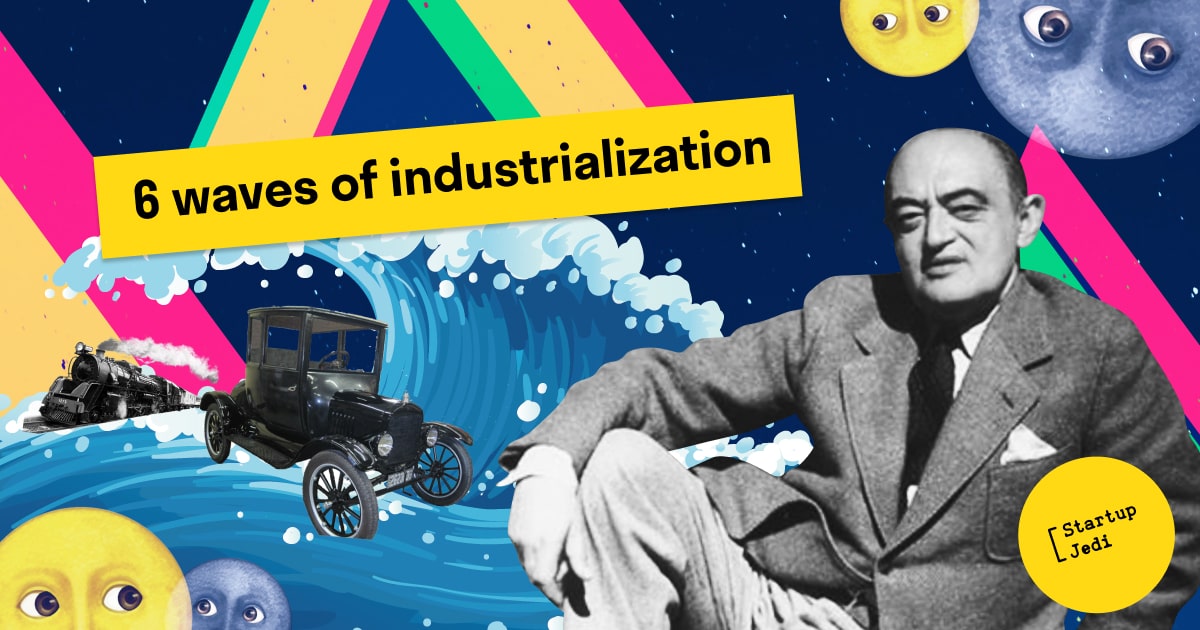
Startup Jedi
We talk to startups and investors, you get the value.

Startup Jedi
We talk to startups and investors, you get the value.
The 250 years of the industrial revolution haven’t been the same. According to Joseph Schumpeter, who coined the term "creative destruction" in 1942, there are distinguished six waves of industrialization. It was he who traced the role of innovation depending on business cycles. In today's article, we will plunge into the history of industrialization and see what is happening right before our eyes.

The first wave of industrialization began at the end of the 18th century, circa 1785, when the energy of water came to the fore, which made it possible to make paper, textiles and iron products. Unlike the watermills of the past, which were already in use long before, the 18th century brought full-size turbines with complex belt systems. Progress in the textile industry led to the emergence of the first factories and this led to the development of cities around them. The duration of the first wave of industrialization is usually estimated at 60 years.

With the advent of the second wave of industrialization, which lasted from 1845 until the beginning of the 20th century, steam energy came to the top, which led to the development of railways and the steel industry. The railways have catalyzed changes in many industries, from iron ore to oil, from steel to copper. At the same time, railroad monopolies started to form. The second wave of the industrial revolution lasted just over half a century.

The third wave burst into the world with the light of an electric bulb and the sound of telephone conversations, dominating at the beginning of the 20th century. Henry Ford unveiled his first Model T car, set up an assembly line, which significantly increased the productivity of automobile factories. Thanks to this, cars have become the reason for the development of American megacities. At the same time, World War I accelerated the growth of scientific thought on both the European and American continents. And the collapse of empires that followed it led to the development of nation states, each of which wanted to leave its mark on the history of innovation. It is customary to define the duration of the third wave of industrialization at 50 years.

The fourth wave of the industrial revolution took people off the ground and revolutionized traveling by cutting travel time: both on continent and on intercontinental levels. Aviation turned out to be one of the decisive forces of the Second World War, which further accelerated scientific progress around the world. Simultaneously with aviation, mankind conquers the energy of the atom, which has become both the basis for modern energy and a deadly weapon that practically wiped out two Japanese cities: Hiroshima and Nagasaki, determining the outcome of World War II. This wave has been swepting the world for 40 years.

Many of our readers were born or have seen the fifth wave of industrialization, which began in the 1990s with the invention of the World Wide Web and changes in the media space. If earlier either the state or large corporations possessed a monopoly on information, then the Internet has made it possible for everyone to become the owner of their own information agency "named after themselves" (after all, such information agencies are your posts on social networks, videos and photos that you share in the digital space). The Internet has become the new "cutting edge" of globalization, blurring the physical boundaries between countries in the digital world and creating new information flows. The fifth wave lasted for 30 years, but it has already been replaced by the sixth wave of the industrial revolution, which is happening right now.

During the sixth wave, individual islands of digitalization are turning into a common digital space, including artificial intelligence, the Internet of Things, robotization and small aircraft in the form of a variety of drones. Thanks to the focus on the environment, clean energy technologies are gaining momentum: from solar power plants to electric vehicles, which were invented in the early 20th century, but were supplanted by cars with internal combustion engines for a century. The sixth wave continues for a quarter of a century, and, probably, the seventh wave will be a new space age, which will open the way for humanity to colonize other planets and transform into an interplanetary species.

From a market point of view, each wave has spurred economic development and improved living standards in the world. Moreover, each wave led to the formation of new monopolies, when the strongest players received huge margins, pushing competitors out of their area of interests. Often, each of the waves began with innovations that became the subject of widespread use over time. This is also the case today, as tech giants are establishing a monopoly on search traffic, social interaction, and advertising.
Facebook: facebook.com/StartupJedi/
Telegram: t.me/Startup_Jedi
Twitter: twitter.com/startup_jedi
Comments